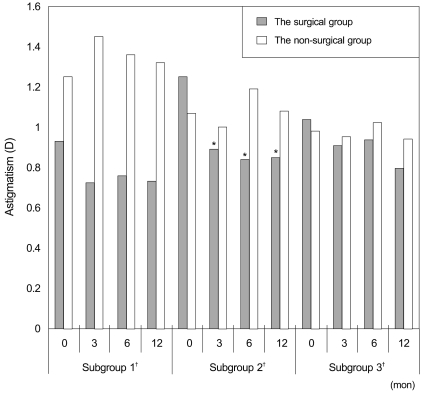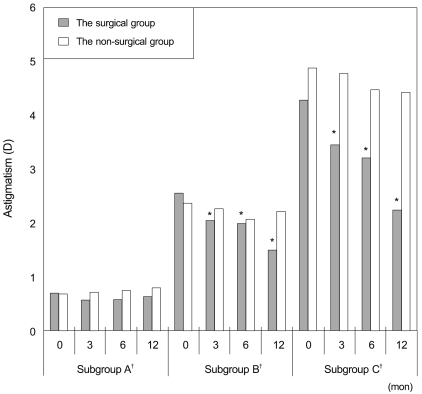Korean J Ophthalmol.
2010 Dec;24(6):325-330. 10.3341/kjo.2010.24.6.325.
The Effect of Epiblepharon Surgery on Visual Acuity and With-the-Rule Astigmatism in Children
- Affiliations
-
- 1Department of Ophthalmology, Pusan National University Hospital, Busan, Korea. hychoi@pusan.ac.kr
- 2Department of Ophthalmology, Pusan National University Yangsan Hospital, Yangsan, Korea.
- 3Medical Research Institute, Pusan National University, Busan, Korea.
- KMID: 1769084
- DOI: http://doi.org/10.3341/kjo.2010.24.6.325
Abstract
- PURPOSE
To evaluate the effect of epiblepharon surgery on visual acuity and with-the-rule astigmatism in children compared to patients without surgical treatment.
METHODS
We undertook a retrospective case control study and reviewed the charts of 202 eyes treated with epiblepharon surgery and of 142 eyes without surgery. The surgical procedure for epiblepharon correction used rotating suture techniques. Data regarding age, best corrected visual acuity, and degree of astigmatism were recorded. Baseline and 1-, 3-, 6-, and 12-month postoperative data were collected. The chi-square test, Student's t-test and general linear model analysis for repeated measures were applied.
RESULTS
The mean astigmatism in the surgical group decreased from 1.10 +/- 1.02 diopter (D) preoperatively to 0.84 +/- 1.05 D at 3 months after surgery (p < 0.05). However, there was no statistically significant difference compared to the non-surgical group during the first year. The general linear model analysis comparing the mean astigmatism between the two groups over time showed a significant group-time interaction (p < 0.05). Within the surgical group, the higher baseline astigmatic subgroup and the 5- to 8-year-old group demonstrated greater cylinder reduction over time. The change in mean visual acuity was not significant in either group.
CONCLUSIONS
Significant astigmatic reduction was found after surgical correction in epiblepharon patients. Patients with higher baseline astigmatism exhibited greater astigmatic reduction after epiblepharon surgery. These results suggest that, in order to reduce astigmatism, an epiblepharon operation should be considered in patients with a high level of astigmatism.
Keyword
MeSH Terms
Figure
Cited by 2 articles
-
The Effects of Epiblepharon Surgery on the Improvement of Astigmatism
Wan Seok Kang, Min Ahn
J Korean Ophthalmol Soc. 2014;55(3):343-347. doi: 10.3341/jkos.2014.55.3.343.Relationship between Palpebral Fissure Height and Corneal Astigmatism of Epiblepharon
Jinsoo Kim, Hyo Sung Yoon, Joo Yeon Lee
J Korean Ophthalmol Soc. 2017;58(2):192-196. doi: 10.3341/jkos.2017.58.2.192.
Reference
-
1. Levitt JM. Epiblepharon and congenital entropion. Am J Ophthalmol. 1957; 44:112–113. PMID: 13435337.
Article3. Noda S, Hayasaka S, Setogawa T. Epiblepharon with inverted eyelashes in Japanese children. I. Incidence and symptoms. Br J Ophthalmol. 1989; 73:126–127. PMID: 2930758.
Article4. Shih MH, Huang FC. Astigmatism in children with epiblepharon. Cornea. 2007; 26:1090–1094. PMID: 17893541.
Article5. Preechawai P, Amrith S, Wong I, Sundar G. Refractive changes in epiblepharon. Am J Ophthalmol. 2007; 143:835–839. PMID: 17362867.
Article6. Lee DP, Kim SD, Hu YJ. Change of visual acuity and astigmatism after operation in epiblepharon children. J Korean Ophthalmol Soc. 2001; 42:223–227.7. Baek SH, Heo NH, Lee KS. Corneal topographic changes after surgery in epiblepharon children. J Korean Ophthalmol Soc. 2002; 43:1841–1846.8. Woo KI, Yi K, Kim YD. Surgical correction for lower lid epiblepharon in Asians. Br J Ophthalmol. 2000; 84:1407–1410. PMID: 11090483.
Article9. Holck DE, Dutton JJ, Wehrly SR. Changes in astigmatism after ptosis surgery measured by corneal topography. Ophthal Plast Reconstr Surg. 1998; 14:151–158.10. Robb RM. Refractive errors associated with hemangiomas of the eyelids and orbit in infancy. Am J Ophthalmol. 1977; 83:52–58. PMID: 835667.
Article11. Read SA, Collins MJ, Carney LG. The influence of eyelid morphology on normal corneal shape. Invest Ophthalmol Vis Sci. 2007; 48:112–119. PMID: 17197524.
Article12. Garcia ML, Huang D, Crowe S, Traboulsi EI. Relationship between the axis and degree of high astigmatism and obliquity of palpebral fissure. J AAPOS. 2003; 7:14–22. PMID: 12690364.
Article13. Collins MJ, Kloevekorn-Norgall K, Buehren T, et al. Regression of lid-induced corneal topography changes after reading. Optom Vis Sci. 2005; 82:843–849. PMID: 16189495.
Article14. Koenig SB, Smith RW. Keratoconus and corneal hydrops associated with compulsive eye rubbing. Refract Corneal Surg. 1993; 9:383–384. PMID: 8241044.
Article15. Mansour AM, Haddad RS. Corneal topography after ocular rubbing. Cornea. 2002; 21:756–758. PMID: 12410030.
Article16. Wilson SE, He YG, Weng J, et al. Epithelial injury induces keratocyte apoptosis: hypothesized role for the interleukin-1 system in the modulation of corneal tissue organization and wound healing. Exp Eye Res. 1996; 62:325–327. PMID: 8795451.
Article17. Jafri B, Lichter H, Stulting RD. Asymmetric keratoconus attributed to eye rubbing. Cornea. 2004; 23:560–564. PMID: 15256993.
Article
- Full Text Links
- Actions
-
Cited
- CITED
-
- Close
- Share
- Similar articles
-
- Change of Visual Acuity and Astigmatism after Operation in Epiblepharon Children
- The Effects of Epiblepharon Surgery on the Improvement of Astigmatism
- Visual Acuity and Astigmatism after Simultaneous Surgery for Upper and Lower Eyelid Epiblepharon in Children
- Astigmatism in Children with Epiblepharon
- Estimation of Subjective Visual Acuity and Refractive Error



